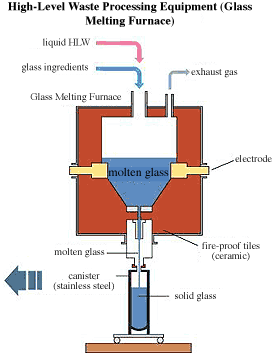Tests of the Rokkasho Reprocessing Plant using spent nuclear fuel (active tests) commenced in March 2006. Production of plutonium began in November of the same year and 3,283 kilograms of MOX powder (50-50 mixture of plutonium oxide and uranium oxide) had been stored at the plant by November 2007. Production of high-level radioactive waste (HLW) glass canisters began in November 2007, but it is now clear that the process is not going smoothly.
The vitrification process employed at Rokkasho is different from the rotary kiln process used at the reprocessing plants at La Hague (France) and Sellafield (UK). At Rokkasho the Liquid Fed Ceramic Melter (LFCM) method developed at the Tokai Reprocessing Facility is used.
The Tokai Reprocessing Facility commenced operations in 1977, but the vitrification facility did not begin operating until 1995. In the LFCM method, high-level liquid waste and glass ingredients are mixed in a high-temperature melting furnace made of fire-proof ceramic tiles. The mixture is then poured into stainless steel containers, where it cools to form glass canisters. The melting furnace is designed so that the molten glass flows down a slope into the stainless steel containers (see diagram). There is a flow nozzle at the bottom end of this slope.

The temperature inside the furnace is supposed to be maintained at 1,100 to 1,200 degrees C. However, due to difficulties with temperature control, there were frequent problems with increased viscosity and accumulation of radioactive platinum group metals at the bottom of the furnace. In response, design changes and modifications were carried out and a modified melting furnace was introduced from 2002 to 2004. The Tokai facility only managed to produce 244 glass canisters in 12 years to 2007.
While this technical development was being carried out at Tokai, construction of the Rokkasho Reprocessing Plant had already commenced in 1993. Whenever design changes and modifications were made due to problems and accidents at the Tokai facility, design changes had to be made to the glass vitrification facility under construction at Rokkasho. The reality is that the glass vitrification technology employed at Rokkasho is still under development.
There are two melting furnaces, each with a theoretical capacity to process 70 liters of liquid waste per hour, installed at the glass vitrification facility at Rokkasho. However, as pointed out in the Denki Shimbun Newspaper, "To date, it cannot not necessarily be said that this is a stable situation." At the end of December Japan Nuclear Fuel Ltd. (JNFL) announced, "Due to increased viscosity of the molten glass and a doubling of the time required for the glass to flow down" (without resting for a single day during Japan's main holiday period) "from December 27th we will clean out the molten glass in the melting furnace." (Quoted from JNFL's web site.) The net result is that only 21 glass canisters have been produced so far at the Rokkasho Reprocessing Plant.
As a consequence of this problem, another problem arose. Due to the fact that the glass vitrification process did not proceed as planned, more high-level liquid waste was required to complete Step 4 of the active tests. Therefore, at the beginning of January 2008, JNFL went ahead and sheared 30 tons of spent BWR fuel scheduled for Step 5 of the active tests. This obviously means that not enough glass canisters have been produced to satisfy the requirements of Step 4. It could also mean that a very large quantity of molten glass that did not reach the stainless steel containers was scraped out from the melting furnace.
For the glass vitrification function during Step 4, the Nuclear Industrial Safety Agency requires that "JNFL confirm that the two melting furnaces, A and B, have the capacity to process 70 liters per hour." However, the reality is that it will take some time to confirm this. Step 4 still has not been completed and during Step 5 a further 160 tons of spent BWR fuel is scheduled to be sheared. All the reports say that it is now impossible to begin full operation of the Rokkasho Reprocessing Plant by the end of February 2008, but JNFL is yet to concede this.

